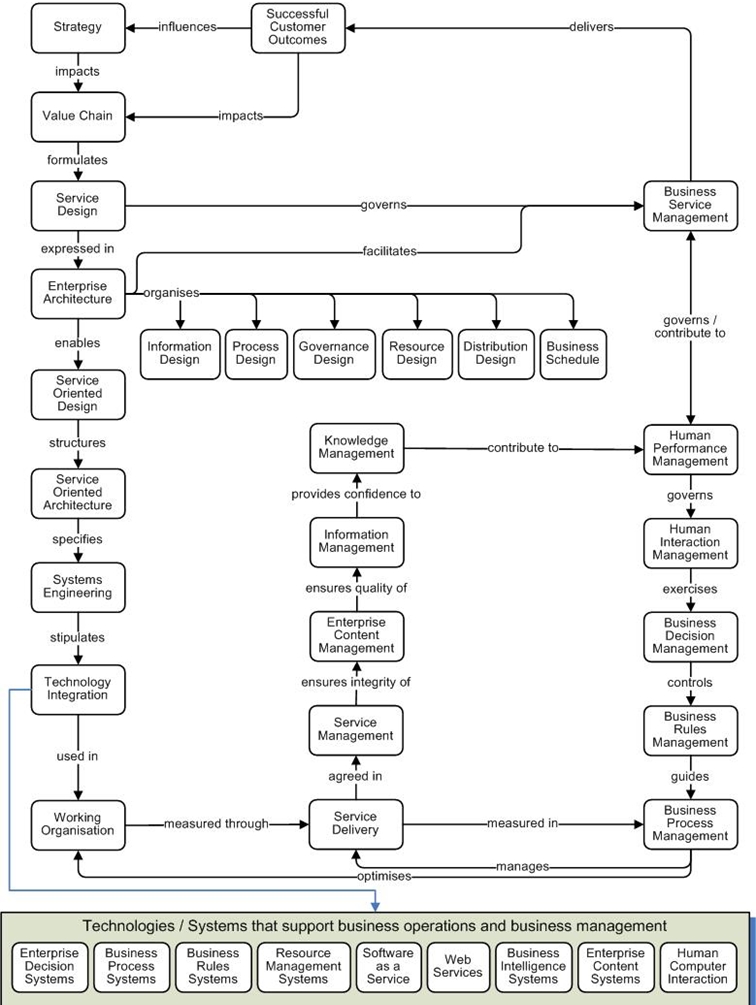In the previous article “Integrated Business Management in the Process Age”, I discussed the concepts that will shape businesses in the Process Age. In this article I will discuss how process-oriented concepts and systems engineering practices can be used in a process-oriented engineering methodology.
For a system to be successful, that is to be human-centric and process-oriented, it must provide a rich set of features that support automation and adaptation of human interaction with processes. These features must reflect the complexities of the way people work and interact with each other, as they will make the difference between a system that is flexible, usable and natural compared to a system that is rigid and treats people as automatons. People will bypass and reject any system that does not help them perform work in a natural way. After all, processes do not manage people – people manage processes.
Real-time Process Execution:
In dealing with process execution, we have to deal with the unexpected. This is not just about using a set of tools to deal with every anticipated business outcome or rule. It’s about managing the true interaction that takes place between individuals, which cannot be predicted or encapsulated beforehand.
Business processes exist at two levels – the predictable (the systems) and the un-predictable (the people).
The predictable aspects of the process could easily be catered for by Business Process Management Systems, but Business Process Management is not only about the integration aspects. It is also about the interaction aspect and the management of both the integration (a set of integrated tools and technologies) and the interaction (performance and innovation).
The unique circumstances that characterise the specific instance of the use of a process will determine the execution of the process. If nothing is out of the ordinary, the actions of the person performing the process and the flow of the process are predictable, measurable and accounted for. The tools and technologies deployed to allow for predictable workflow and measurements, will work well in this setting.
If the circumstances require intervention beyond the anticipated control of the process, human innovation will find a way to deal with the circumstances. Unfortunately, the choice of activities to cater for the different circumstances will more often than not be detrimental to the rest of the process flow. Current technologies do not allow for the recognition and recording of these un-predictable activities.
People are managed and motivated by the successful outcomes of the process. When these successful outcomes are challenged by unpredictable circumstances, successful customer outcomes can most often only be achieved by human intervention. These successful customer outcomes are however unmanaged and not aligned to the performance rating associated with the effort. Not only will this stifle innovation, it will probably cause a circumvention of a large part of the process to ensure that the measurement corresponds with the effort of the unpredictable activities.
Impact on Systems Engineering:
Current information systems are built around how people store, manipulate, retrieve, interpret and move data. They are designed to represent data and operations on data. A rigid approach to engineering information systems is essential, but where people are concerned the perspective must be one of flexibility.
At the core of information systems is the raw data which is utilised to satisfy the organisation’s information requirements. Recent advances in technology have inspired the creation of systems to manage business rules, process execution, business intelligence, human resources and customer relationship systems to “manage” the information about a customer.
If we visualise an organisation’s environment as the total of all interactions among the elements of the organisation, we are faced with the challenge of presenting this environment from a data point of view. Rather visualise these interactions as the execution of processes encapsulated in services to be able to provide for and support the different elements.
Process-Oriented methodologies:
The following methodologies can help to overcome the shortcomings of information systems. Some of these methodologies already have associated tools / technologies.
Business Process Management
BPM encapsulates the management discipline that will facilitate the view of business processes as assets to be valued, designed and exploited in their own right. It is a structured approach that guides the methods, policies, metrics, management practices and technology required to manage and continuously optimise an organisation’s processes and activities. BPM quantifies, predicts, monitors and optimises process performance. Success is measured by quantitative performance metrics and targets – whether based on cost, time, profit, efficiency or compliance.
Business Decision Management
BDM encapsulates the structured analysis and application of strategy, policies, decisions, business rules and regulatory requirements into decision tables to facilitate managed, and possibly automated, decision resolution and judgement. Decisions are critical business assets that must be managed.
Decisions are implemented through logical gates (process rules) and control structures (business rules) in the process, Boolean logic in systems engineering (product and data rules) and criteria in performance management.
Object-Process Methodology
The OPM treats processes as organisational building blocks alongside objects to enable coherent modelling of the system’s dynamics. The behaviour of the system is integrated with the object model and complements it. Coupled with Object-Oriented Analysis and Design, it enables an analytical view of processes as a hierarchy of objects with its associated behaviours. Objects are things that exist, while processes transform objects from one state to another. States are the situations an object can be in or an object can be at.
This methodology makes encapsulation, inheritance and collaboration available to the design of processes. The Business Process Modelling Notation can be used in conjunction with this methodology to produce process object modelling.
Service Oriented Design
The object-oriented view of processes will enable the design of services to be re-usable, independent and autonomous. Each service will be governed by the processes it services as well as the business rules that control its utilisation.
The good practices of Service Management (according to ITIL) are integral to the effective deployment of these services. Services are implemented using the principles associated with Service Oriented Architecture, such as the enterprise service bus, layered services and re-usable information systems.
Automated Process Optimisation
The practical implementation of Automated Process Optimisation (APO) will go a long way in achieving the business agility that is required to adapt to the changing environment through continual improvement.APO starts at the design of the process. It assists with engineering efforts such as simulation, comparing scenarios, reducing defects and eliminating waste. The process is translated from the modelling environment into a process execution language that can be executed by a process engine.
The same metrics and KPIs defined in the design are used to monitor actual performance in the process implementation, displaying results in management dashboards and executing rule-triggered notification and remediation automatically via the process engine.
The process measures its execution against the rules and service level agreements governing it to optimise workload and the distribution of work among the process resources. It anticipates peaks and troughs to allocate resources to processes as required.
APO formally describes the concepts of patterns, measurability, and more importantly, that which is immeasurable. Technologies in this context will facilitate automated process discovery and mapping, automated rules discovery and mapping, automated process execution and automated process optimisation.
Human-Computer Interaction
Human Computer Interaction (HCI) explores the concept of animating human interactions with systems. These interactions span across end-to-end business processes, where teams may be scattered across the globe.
HCI processes span internal processes, your suppliers, your suppliers’ suppliers, your employees, your customers, and your customers’ customers. This forms the basic network of a complete value delivery system. Human-driven processes will fuse traditional collaboration and information tools (groupware, knowledge management, workflow, and system-to-system messaging) and extend them with a complete theory of human work. Thus systems can support the way people actually work, versus treating them as cogs in an information machine.
Next-generation interactive technologies bring additional challenges. The focus will be on designing interactive processes that enhance and extend the way people communicate, interact and work. It will incorporate the cognitive, social and affective issues that underpin HCI.
Artificial Intelligence
Systems using AI were intended to think as humans do. These systems “duplicate” the reasoning of a human, which translates into a combination of rules, data and processing. The biggest challenge with AI is still the interaction of the system with its environment.
-
build “robots” or automated systems to perform repetitive and labour intensive work;
-
build thinking systems that use the above methodologies and designs to anticipate and resolve unexpected interaction of human behaviour.
Human Performance Management
Human Performance Management (HPM) must consider the following:
-
HPM must align work performed to strategy.
-
It must be governed by business rules.
-
Measurements must be taken objectively by the process utilised to perform the work.
-
Measurements must be aligned to successful outcomes as well as the use of the process.
-
In the absence of a process, measurements must still be taken, but they should be viewed as subjective.
-
Performance management and reward is a continual process.
-
The right reward at the right time initiate motivation to perform beyond expectation.
Systems in the Process Age:
These methodologies need further research into their possible application, but I am convinced that these (and possibly others) will shape our thinking about designing and engineering future systems.
Some of these methodologies fit into an Integrated Business Management paradigm. Process-oriented concepts and systems engineering practices can be incorporated into a Process-Oriented Engineering Model that supports Integrated Business Management.

















